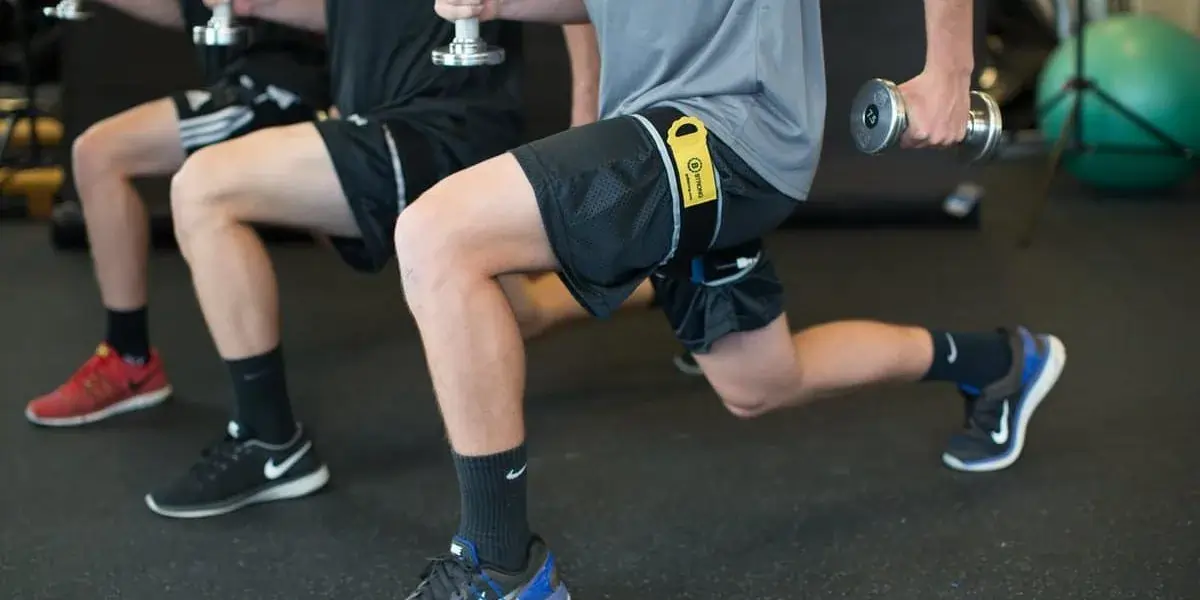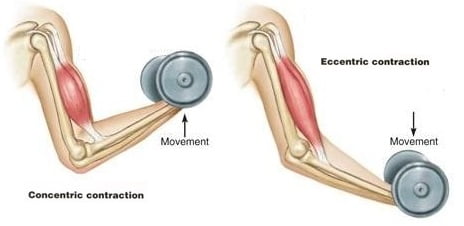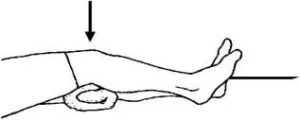Blood Flow Restriction Training (BFR)
What is a Blood Flow Restriction Training (BFR)?
Blood Flow Restriction (BFR) Training is a specialized exercise technique that enhances muscle strength and growth by partially restricting blood flow to the limbs during low-intensity workouts.
A common symptom of many illnesses and diseases is muscle weakness. High-load resistance training is the most efficient method for achieving muscular hypertrophy and strength growth. However, for certain groups who require muscle strengthening, such as individuals with chronic pain or those recuperating from surgery, high-load and high-intensity exercises may not be therapeutically appropriate.
Muscle growth and strengthening may be beneficial for those with HIV, diabetes, and COPD, but these diseases cannot withstand strenuous or high-intensity exercise.
By combining low-intensity exercise with blood flow obstruction, blood flow restriction (BFR) training replicates the benefits of high-intensity training. It has been used in gyms for a long time, but its use in therapeutic contexts is expanding.
Training for Blood Flow Restriction (BFR)
A tourniquet, also known as a pneumatic cuff, is placed proximally on the muscle being worked out. It can be applied to either the lower or higher limbs.
The patient is then directed to perform weight training at a low intensity of 20–30% of 1 repetition maximum (1RM), with high repetitions (15–30) per set and short rest intervals (30 seconds) in between sets.
Physiology/Mechanism of Action
The general opinion, despite a number of theories, is that metabolic stress from vascular occlusion and mechanical strain from exercise or resistance training work in concert to increase muscular strength and hypertrophy.
At the cellular level, metabolites, hormone changes, cell-to-cell communication, cellular growth, and intracellular signaling pathways have all been connected. Since BFR at low loads has the same recruitment as resistance training at high loads, they likely induce early peripherally mediated fatigue, which in turn causes a rise in motor unit recruitment. Low-load BFR also leads to greater muscle growth than similar low-load exercise alone because it engages type II fast-twitch muscle fibers, which are normally only recruited preferentially at higher intensities, at lower loads.
However, there is no enhanced recruitment of motor units in muscles located far from the occlusion point. This is thought to occur when synchronous muscle groups located far from the occlusion location are exhausted early. The use of BFR after surgeries or incidents where proximal tourniquet administration is not feasible is significantly impacted by this.
The growth of multipotent satellite cells, which are in charge of muscle development and regeneration, inside the connective tissue of muscles may be the cause of the supraphysiologic effects of BFR exercise. BFR encourages the proliferation of satellite cells even at low loads, which results in increases in muscle protein synthesis, myonuclei content, myofiber size, and muscular strength. This is contrary to the early notion that satellite cells could only be activated during high-resistance training.
It has also been demonstrated that the physiological alterations seen during and after BFR are mediated by a number of significant cell signaling pathways.
The activation of protein translation through the molecular target of the rapamycin pathway, which is essential for muscle protein synthesis and hypertrophy, seems to be the main mechanism underlying BFR’s actions. On the other hand, it has been demonstrated that myostatin, a hormone that promotes muscle fibrosis and inhibits muscle growth, is downregulated after BFR.
Even while the exact function of each mechanistic route is yet unknown, the information already available offers helpful direction for a future study that aims to maximize rehabilitation efforts.
BFR and Strength Training
- Understanding the Physiology of Growing Muscle
- Muscular hypertrophy is the term used to describe a growth in the diameter of the muscle as well as the protein content of its fibers. Increases in the cross-sectional area of the muscle are closely associated with increases in strength.
Muscle strain and metabolic stress are the two primary causes of muscular hypertrophy.
- Mechanical Tension and Metabolic Stress
- Mechanical stress on a muscle increases the concentration of anabolic hormones. Increased protein metabolism and anabolic hormones brought on by myogenic stem cell activation may contribute to muscle growth.
Hormones are released, hypoxia occurs, and cell swelling occurs whenever a muscle undergoes metabolic stress. Each of these components plays a part in muscle tissue anabolism.
Activation of myogenic stem cells
- Myogenesis
Myogenic stem cells, also known as satellite cells, are found between the basal lamina and the plasma membrane of the myofibre. Normally inert, they become active when muscles are strained or injured. These cells regulate the development of new muscle fibers as well as the healing of damaged ones.
Release of hormones
HGH function
Any form of exercise, whether resistance or aerobic, dramatically raises human growth hormone (HGH). Increased collagen synthesis during exercise promotes muscle regeneration and is brought on by growth hormone and insulin-like growth factors.
Growth hormone may accelerate the process of developing stronger muscles by promoting muscle recovery, even though it does not directly cause muscular hypertrophy. When hydrogen ions and lactate accumulate, as they do during hypoxic training, for instance, growth hormone is released even more quickly.
High-intensity exercise has been shown to downregulate myostatin, which creates the perfect environment for muscle growth. Myostatin controls and inhibits the growth of cells in muscle tissue. It needs to be essentially turned off for muscle growth to occur.
Hypoxia
Resistance training compresses the blood vessels inside the trained muscles. A hypoxic environment is created due to the muscle receiving less oxygen. This leads to an increase in both anaerobic lactic metabolism and lactate production. leads to an increase in lactate generation and anaerobic lactic metabolism.
Cell Swelling
When metabolites accumulate and blood pools, cell swelling occurs. This cell expansion triggers an anabolic response that results in muscle growth. As discussed before, the myogenic stem cells may be activated by the mechanical strain resulting from the cell expansion.
Blood Flow Restriction’s Effects on Muscle Strength
Low-intensity workouts can be done after the cuff has been positioned near the muscle being worked.
Because the cuff limits blood outflow, allowing low-oxygen blood to accumulate and increasing protons and lactic acid, BFR training, and low-intensity exercise will cause the same physiological adaptations to the muscle (e.g., hormone release, hypoxia, and cell swelling) as would occur with high-intensity exercise.
Muscular circumference rises when low-intensity BFR training is coupled with consistent low-intensity exercise.
It also speeds up the activation of fast-twitch muscle fibers. Furthermore, it is anticipated that after the cuff is removed, hyperemia—an overabundance of blood in the blood vessels—will occur, exacerbating the cell swelling.
These improvements were on par with the advantages of vigorous exercise without BFR.
For six weeks, all four training regimens resulted in increases in torque, muscle activations, and muscular endurance; however, the BFR (groups 3 and 4) and high intensity (group 1) had the biggest effect sizes and were comparable to each other.
Equipment
BFR Cuff
BFR requires applying a tourniquet on a limb. The cuff must be tightened to a specific pressure during exercise in order to prevent venous flow while preserving arterial flow.
Basic equipment such as elastic bands or surgical tubing has been used in gym settings to achieve this effect.
These are not advised since it is impossible to monitor the level of blood flow restriction. Additionally, excessive local pressure caused by a restricted diameter may cause tissue damage.
BFR Cuff Width
When using BFR correctly, a broad cuff is preferred. Cuffs that measure 10 to 12 cm are usually used. Perhaps 15 cm is the ideal cuff width to provide consistent restriction. Modern cuffs are made to fit the arm or thigh’s natural curvature, narrowing from proximal to distal. There are extra limb-specific cuffs for the upper and lower extremities for better fit.
BFR Cuff Material
Rubber or cotton can be used to make BFR cuffs. Nylon typically creates the wider cuffs, whereas elastic typically creates the narrower ones. Elastic cuffs, as opposed to nylon cuffs, have a starting pressure before they are inflated, which influences how effectively they may limit blood flow.
It has been demonstrated that compared to nylon cuffs, elastic cuffs offer a noticeably higher arterial occlusion pressure.
BFR Cuff Pressure
There are several methods for recommending cuff pressure in cases of blood flow restriction:
All patients have a baseline pressure of 180 mmHg; they also have a pressure that is 1.2 or 1.5 times greater than their systolic blood pressure; and they possess a Pressure proportional to their thigh circumference.
It is recommended to utilize a pressure that is specific to each patient because different pressures impede the amount of blood flow for everyone under the same circumstances.
Measurements of blood flow to the afflicted limb can be made using Doppler ultrasonography or plethysmography. When the cuff is fully tightened, arterial blood flow stops completely. This pressure is known as artery occlusion pressure (AOP) or limb occlusion pressure (LOP). After that, the cuff pressure is computed as a percentage of the LOP, often ranging from 40% to 80%.
This approach is the most effective way to ensure that patients are using the appropriate cuff and exercising at the proper pressure. Not only is it safer, but it also guarantees that the workout pressure is just right—not too low to be ineffective, nor too excessive to damage tissue.
The width of the cuff and the size of the limb it is fastened to determine how much pressure is imposed.
Maintaining arterial input at a high enough pressure to let blood pool while limiting venous return is essential for BFR. A perceived wrap tightness of seven out of ten led to complete venous occlusion while allowing arterial input, according to Wilson et al. (2013).
Procedure
- Upper Limb: The upper arm receives the triquetrum. 50% of arterial blood flow and all venous blood flow are stopped by the inflated cuff.
- Lower limb: The tourniquet is applied to the upper thigh. Frequent workouts are performed at 20–30% of 1RM once the cuff has been properly inflated.
Is exercising with blood flow restriction safe?
The majority of people can safely finish BFR training, according to all three experts, though there are a few situations when it wouldn’t be advised. BFR training is inappropriate due to the following medical conditions:
- Cancer.
- Blood clotting issues.
- Bone fracture.
- Infection.
- Pregnancy.
Dempers suggests speaking with a specialist who can guide you through the effective and safe use of BFR bands. Look for someone who can collect your medical history. Following that, you may be certain that you have no medical issues that would render BFR training harmful.
Exercise Prescription
Depending on whether bone mineral density reduction (BFR) is achieved through strength training (BFR-RE), aerobic training (BFR-AE), or passive training (P-BFR), different levels of exercise are advised.
- Exercise prescription model using BFR-RE
BFR-RE (resistance training)
Exercise prescription model using BFR-AE
For optimal results, resistance training should ideally be performed two to four times a week. Strength training with BFR may not be the best long-term strategy, even though it is theoretically feasible to do so daily. Rather, training should only be done 1-2 times a day for short periods of 1-3 weeks.
The majority of research suggests longer training durations of more than three weeks, even though BFR-RE can induce muscle growth in as little as three weeks.
Muscle adaptations for BFR-RE have been demonstrated to be regularly developed at loads ranging from 20-40% 1RM.
- The most frequently used training volume in the literature is 75 repetitions divided into 4 sets.
- Between sets, there is often a 30- to 60-second rest period.
- The cuff must remain inflated when at rest to collect the metabolites. Constant pressure is more effective than intermittent pressure.
Exercise Prescription Model Using P-BFR
The size of the limb determines how much pressure is required to stop blood flow in it. the soft tissue underneath, the cuff’s width, and the device being utilized. The arterial occlusion pressure should be between 40% and 80%, depending on whether the limb is upper or lower.
BFR-AE (aerobic training)
BFR is frequently utilized in studies when walking or cycling, even though it can be used during aerobic activities. It’s a little more difficult to maintain cuff pressures during BFR-AE, and not much research has been done on the topic. Additionally, there is no evidence that BFR training improves an athlete’s performance or aerobic capacity.
P-BFR (passively without exercise)
Research on BFR that is delivered passively, or without any activity, is few. However, it has shown encouraging results in reducing muscle atrophy after ACL surgery. Because standardized pressures were not used in the research and because some of the pressures were high enough to completely block blood flow, there are safety concerns. Although additional research is needed in this area, P-BFR may benefit people recovering from surgery.
Benefits of using blood flow restriction bands
Using BFR bands has the following advantages:
- increases muscle mass faster than with consistent training.
- results in lifting gains that are comparable to those of regular training while using 20% to 30% fewer weights or repetitions.
- less damage to tendons and joints from lifting.
- prevents immobile people’s muscle loss.
Side Effects
BFR workouts have been linked to symptoms such as dizziness, fainting, delayed onset muscular soreness, numbness, and stiffness and pain.
Contraindications
Every patient should have their risks and tourniquet usage contraindications assessed before utilizing BFR.
- Negative reactions may be more likely to occur in those with sickle cell trait, obesity, diabetes, arterial calcification, severe hypertension, reduced circulatory function, or renal impairment.
- Consider the following potential contraindications: venous thromboembolism, peripheral vascular compromise, sickle cell anemia, infection of the extremities, lymphadenectomy, cancer or tumor, dialysis-accessible extremity, acidosis, open fracture, elevated intracranial pressure, vascular grafts, or medications that increase the risk of clotting.
Safety Implications
The implications of BFR on safety are not fully known. Muscle damage and the emergence of venous thromboembolism, which includes pulmonary embolism and deep vein thrombosis, are the two main safety issues. Numerous safety issues and their consequences are covered in the following:
Blood hemostasis and BFR
There are numerous coagulation pathways via which blood might clot. A blood clot can be prevented from developing into a venous thromboembolism with the use of fibrinolysis.
Da Cunha Nascimento et al. conducted a systematic investigation in 2019. examined the immediate and long-term impacts on blood hemostasis or the balance between fibrinolysis and coagulation. It was determined that more field research is necessary before definitive recommendations can be given.
In their review, they expressed worry regarding the following:
Not every negative consequence was reported.
- The person’s level of prior training, which significantly affects the physiological response, was not mentioned.
- The research employed a wide range of pressures, as well as a variety of occlusion criteria and methodologies.
- Long-term impacts were not evaluated, and most study was conducted in the short term.
- Participants at risk for diabetes, obesity, thromboembolic disorders, or poor fibrinolysis were excluded from the studies. Rather, they concentrated on those who were healthy.
Conclusion
By promoting muscle growth through a synergistic response to metabolic load and mechanical tension, BFR therapy offers additional benefits for pain and cardiovascular fitness. Novel forms of BFR have the potential to speed up recovery, and its applications in sports and postoperative patients are expanding. Continued attention to rehabilitation guidelines, research into BFR physiology, and a variety of applications are necessary to maximize its effectiveness and prescription.
FAQs
Does blood flow restriction training work?
In fact, at significantly smaller loads than are typically given, BFR can induce muscle growth, leading to larger improvements in muscle strength.
What is blood flow restriction training?
Blood flow restriction, or BFR, is an increasingly popular rehabilitation technique that uses a tourniquet to stop venous outflow and decrease arterial inflow during resistance training or exercise.
What are the risks of BFR training?
Abnormal cardiovascular reactions, high blood pressure, and compromised vascular health can all result from BFRT. Furthermore, people with a history of cardiovascular disease, such as those with diabetes, hypertension, or chronic renal disease, have serious problems using BFRT.
Does BFR training increase muscle?
Strength and muscle hypertrophy gains from BFR training are on par with or higher than those from moderate-to-high-load resistance training. Additionally, it improves strength and hypertrophy more than low-load resistance training alone.
References:
- Parmar, D. (2023, December 13). Blood Flow Restriction Training (BFR) – Big Gains, Less Time. Mobile Physiotherapy Clinic. https://mobilephysiotherapyclinic.in/blood-flow-restriction-training-bfr/
- Work Out Smarter, Not Harder, With Blood Flow Restriction Training. (2024, June 27). Cleveland Clinic. https://health.clevelandclinic.org/blood-flow-restriction-training
- Lorenz, D. S., Bailey, L., Wilk, K. E., Mangine, R. E., Head, P., Grindstaff, T. L., & Morrison, S. (2021). Blood Flow Restriction Training. Journal of Athletic Training, 56(9), 937–944. https://doi.org/10.4085/418-20







